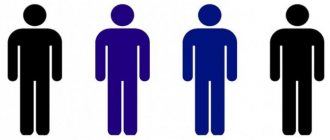The essence of social conflict comes down to a clash of opposing interests. Conflict situations come in different types and can involve just one person (in the case of internal personal conflict) or entire states, as happens when wars break out.
For different types of confrontations, there are different ways to resolve the situation. Conflictology studies and classifies all this in detail, but we will try to parse these expressions in simple language.
Social conflict in simple words
Social conflict (SC) is a tense confrontation between several people or social groups with opposing needs or interests.
Any SC has three stages:
- Pre-conflict – when the parties realize the tension that has arisen between them.
- Active – the direct development of the conflict, which is accompanied by actions aimed at changing the opponent’s opinion.
- Resolution – ending a conflict situation, eliminating its causes.
The parties that are involved in a conflict situation are called subjects of the conflict. In addition to the direct participants, the following may also be present:
- witnesses - outside observers;
- instigators - persons who push for confrontation;
- accomplices - persons who in one way or another contribute to the flare-up of the conflict;
- mediators are persons whose actions are aimed at preventing or resolving a situation.
There is also the subject of the conflict - that which causes the confrontation to flare up.
What is it: concept
The word “conflict” is translated from Latin as “clash” .
There are many types of conflicts, such as political, legal, economic, social.
A social conflict is a clash between two or more parties, caused by the presence of acute contradictions between them, such as a discrepancy in views, goals, and interests.
Social conflicts can have different scales: both individual people and social communities of different scales can act as parties to the conflict.
The most significant social conflicts can lead to paramilitary clashes, civil wars, and revolutions.
Kinds
A detailed classification is offered by Ralf Dahrendorf. He groups them according to specific characteristics.
How many parties are involved:
- intrapersonal – caused by a person’s internal contradictions;
- interpersonal - social interaction between several people who may belong to the same social group or to different ones;
- intergroup – confrontation between social groups.
How the interaction is directed:
- horizontally - between individuals who do not obey each other;
- vertically - between individuals who are connected by a superior-subordinate relationship;
- mixed.
What is the source:
- objectively determined - when an objective problem that needs to be solved led to the SC;
- subjectively determined - caused by personal contradictions and emotions of opponents.
What are the functions:
- creative – leads to positive changes in society;
- destructive - destabilizes the social order.
How long does it last:
- short-term;
- protracted.
What is the internal content:
- rational;
- emotional.
How are they resolved:
- peaceful;
- armed.
What is the essence of the problem that led to SC:
- economic;
- production;
- ideological;
- political;
- family and household;
- legal, etc.
What is the shape:
- interior;
- external.
What is the nature of the occurrence:
- spontaneous;
- deliberate.
What are the scales:
- private;
- group;
- regional;
- local;
- global.
What development tools are used:
- non-violent;
- violent.
How does it influence the development of society:
- progressive;
- regressive.
What areas of life are affected?
- ethnic;
- family and household;
- political;
- economic and so on.
In addition, D. Katz proposes to distinguish social relations between directly and indirectly competing groups, as well as conflict within the group (in this case, the goal is reward).
Motivational approach
From the point of view of this approach, the hostility of a certain individual or group is primarily a reflection of its internal problems. So, for example, from Freud’s position, autogroup hostility is an inevitable condition of any intergroup interaction, having a universal character. The main function of this hostility is a means of maintaining internal stability and cohesion of the group. Political conflicts occupy a special place in this case. Examples can be found in the history of the formation of the fascist movement in Germany and Italy (the idea of racial superiority), as well as in the history of the fight against “enemies of the people” during the period of Stalinist repressions. Freud associated the mechanism of formation of auto-group hostility towards “strangers” with the Oedipus complex, the instinct of aggression, as well as with emotional identification with the leader of the group - “father”, etc. From a moral point of view, such facts cannot be considered as a constructive conflict. Examples of racial discrimination and mass terror, however, clearly demonstrate the possibility of uniting members of one group in the process of confrontation with others.
In the theoretical concept of aggressiveness by American psychologist Leonard Berkowitz, relative deprivation is one of the key factors in intergroup conflicts. That is, one of the groups assesses its position in society as more disadvantaged compared to the position of other groups. At the same time, deprivation is relative in nature, since the disadvantaged position in reality may not correspond to reality.
Causes
The reasons for SC can be different: internal or external, subjective or objective, related to material wealth or ideas, and others. The reason always has a close connection with the needs of opponents.
The most common causes of conflict in modern society are:
- differences in the level of income and, accordingly, access to cultural wealth, information, and education;
- social differences such as sexual orientation;
- religious heterogeneity of society;
- behavior of an individual.
The reason for the SC lies in the presence of a contradiction, but it should not be confused with the conflict itself.
A contradiction is a complete incompatibility of the interests of the parties, but it may not develop into open confrontation.
It is also important not to confuse reason and reason.
The cause is an objective factor that led to the emergence of a conflict situation.
The reason was a minor incident that contributed to the flare-up of the confrontation.
Sometimes the occasion arises by accident, sometimes it is created intentionally.
Classification
Conflicts are divided into:
- Reasons for appearance. There are subjective and objective reasons for the development of the conflict. Objective reasons arise in the absence of control on the part of the individual, while subjective reasons are controlled by him to one degree or another and are closely related to his personality, character, priorities, goals and interests.
- Level of openness. Conflicts are divided into open and closed.
Open conflicts mean situations where the parties directly express their own dissatisfaction: they quarrel, insult opponents, argue, and resort to violence. Closed conflicts are not always noticeable to others; they use indirect methods of influence. - The position of the conflicting parties. If one party to a conflict occupies a higher position and has more power than the other, such conflicts are called vertical. If parties are in conflict, the participants of which are generally equal to each other, such a conflict is horizontal. Accordingly, a conflict between parents and minor children, between a teacher and a student, between a boss and a subordinate, and so on can be considered vertical, while horizontal conflicts usually concern relationships in teams.
- Composition of the parties. If the conflict is not related to differences in ideology or opinion, and the participants do not belong to different ideological communities, such a conflict is called interpersonal. Group conflicts include conflicts in which the parties belong to separate social communities. There are also political conflicts, which are divided into domestic and foreign policy.
- Features of influence on participants. Conflicts can vary in duration (short-term, long-term), degree of scale (global, regional, group, personal), and severity.
- Contents. If the basis of the conflict is the subjective hostility that the parties experience towards each other, then such conflicts are called emotional.
If the essence of the conflict is based on reliable and reasonable argumentation and is not directly related to personal hostility, then this is a rational conflict.
Also, social conflicts in psychology are divided into types:
- socio-political;
- social and labor;
- socio-psychological;
- family and household;
- spiritual and moral;
- ideological;
- environmental;
- legal.
Examples
The most destructive conflicts occur between states - these are wars. Everyone knows the First and Second World Wars.
- NC within the state is confrontation between political parties, citizens going to rallies, revolutions.
- In the family there are disputes about the distribution of finances, about how to properly raise children, quarrels caused by jealousy.
- At work – extended working hours, strikes due to low wages or poor working conditions.
Structure
The conflict structure includes these components:
- Participants. Individuals and certain social associations - organizations, ideological movements, and other communities - can act as participants.
Even states can be participants in a social conflict. - Item. The subject refers to the very essence of the conflict - the contradiction that arose between the participants.
- An object. This is a certain benefit that the parties to the conflict seek to obtain. This could be material wealth, power, maintaining certain spiritual norms, achieving a goal, and much more.
- Macroenvironment and microenvironment. The conditions of the microenvironment and macroenvironment must be taken into account by all parties to the conflict. The microenvironment is the people who surround the conflicting parties and with whom they interact, and the macroenvironment is the social communities that the participants belong to.
Resolution paths
Resolving a conflict situation begins with its analysis. It is necessary to determine the exact causes, understand how to eliminate them, and choose the most effective solution to the insurance system.
This is interesting: How to find a phone through a Google account
There are these:
- compromise - opponents make mutual concessions;
- negotiations - opponents seek a solution during a peaceful conversation;
- mediation – the issue is resolved by a third party;
- arbitration - the situation is resolved by contacting an authorized government agency;
- use of force – the stronger opponent uses force.
Actually, exiting a social conflict can take place according to several scenarios:
- Restoration - the state of affairs that preceded the conflict is restored.
- Non-intervention is the absence of active actions, dictated by the hope that everything will work out on its own.
- Renewal is a departure from old norms and the adoption of new ones.
The most productive way is to combine these paths.
It is important that in order to successfully resolve the conflict, both parties must be interested in this, and they should jointly look for a way to overcome it.
Stages of development
Stages of development of social conflicts:
- First. This is the introductory, pre-conflict stage, which is also divided into hidden and open stages. At the hidden stage, the conflict is just beginning to emerge, the parties comprehend what is happening and its reasons, and at the open stage the first moderate confrontations begin.
- Second. At the first stage of the second stage, the parties develop a desire to continue the confrontation, and expressed hostility appears. The conflict is gradually intensifying. At the second stage, a reversal occurs: the participants in the conflict compare their formed image of the opponent with the real one, and the situation develops depending on their conclusions.
- Third. This is a mature stage of the conflict, during which the parties make their first attempts to solve the problem and look for ways to do this.
- Fourth. At this stage, the conflict disappears entirely or partially.
What are some negative character traits in people? You will find the list on our website.
Description of the stages of social conflict in this video:
Consequences
Positive consequences can be considered that society becomes aware of the presence of social tension and gets the opportunity to relieve it, and at the same time an impetus for favorable changes.
The parties better understand their own interests and recognize the interests of their opponents. Cohesion within groups increases.
The negative consequences are that the usual way of life is completely or partially destroyed, and this leads to stress. The previously established balance of power is disrupted.
Thus, social conflict is one of the ways in which individuals and entire social groups interact.
Its consequences can be both creative and destructive. For a favorable resolution of the insurance case, cooperation of the parties is important.
Situational approach
This approach is focused on external factors, the situation that determines the emergence and specifics of the conflict. Thus, in the research of the Turkish psychologist Muzafer Sherif, it was found that the hostility of one group towards another is significantly reduced if, instead of competitive conditions, they are provided with cooperative conditions (the need to perform joint activities in which the result depends on the common efforts of all participants). Thus, Sherif concludes that the factors of the situation in which groups interact are decisive in determining the cooperative or competitive nature of intergroup interaction.
Signs
Main signs of conflict:
- the presence of circumstances that the parties consider to be conflicting;
- the presence of inconsistency, contradictions in the views, goals, interests of the parties;
- conflict interaction between participants;
- the use of various methods of pressure on opponents (including physical and mental violence);
- results of conflict interaction.
As a rule, conflict situations do not exclusively benefit the parties, and much depends on the specific conflict and the individual characteristics of the participants.
It is also important to consider that each of the participants and observers is able to assess the conflict and its outcome differently.









